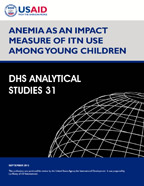- PUBLICATIONS
- JOURNAL ARTICLES
- ORDER PUBLICATIONS
Publications Summary
- Document Type
- Analytical Studies
- Publication Topic(s)
- Anemia
- Country(s)
- Angola, Benin, Burkina Faso, Cameroon, Congo, Congo Democratic Republic, Ethiopia, Ghana, Guinea, Liberia, Madagascar, Malawi, Mali, Niger, Nigeria, Rwanda, Senegal, Sierra Leone, Tanzania, Uganda, Zimbabwe
- Language
- English
- Recommended Citation
- Florey, Lia. 2012. Anemia as an Impact Measure of ITN use Among Young Children. DHS Analytical Studies No. 31. Calverton, Maryland, USA: ICF International.
- Download Citation
- RIS format / Text format / Endnote format
- Publication Date
- September 2012
- Publication ID
- AS31
Download
 Anemia as an Impact Measure of ITN Use among Young Children (PDF, 1898K)
Anemia as an Impact Measure of ITN Use among Young Children (PDF, 1898K)
